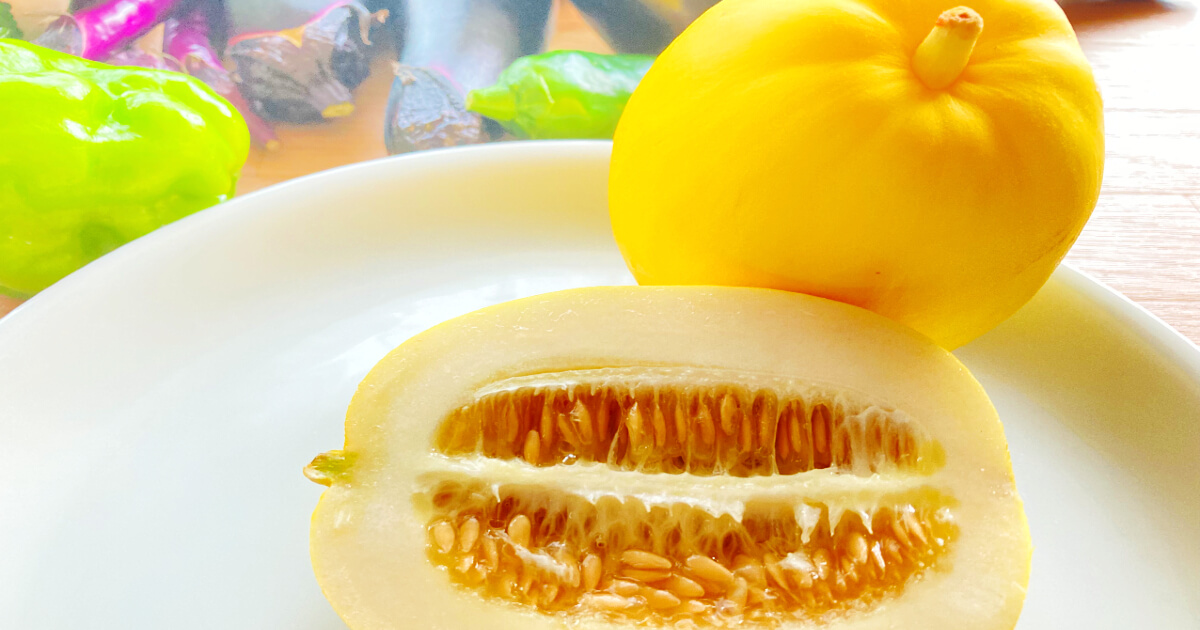Gourd(Uri/瓜) is the generic name for the fruits of the Cucurbitaceae family, including cucumber, watermelon, wax gourd and pumpkin.
The interesting shape of the fruit and leaf vines seems to have led to their being drawn in pictures and becoming a pattern.
We would like to introduce you to the Gourd pattern(Uri mon/瓜文)!
What is Gourd(瓜/Uri)?
 It is mentioned in “Kojiki (古事記/Records of Ancient Matters)” and “Manyoshu (万葉集/Anthology of Japanese Poetry)”, and in olden times, “Makwa-uri(真桑瓜/oriental melon)” was called “Uri”. By the way, the above picture is a Makuwa-uri(真桑瓜/oriental melo).
It is mentioned in “Kojiki (古事記/Records of Ancient Matters)” and “Manyoshu (万葉集/Anthology of Japanese Poetry)”, and in olden times, “Makwa-uri(真桑瓜/oriental melon)” was called “Uri”. By the way, the above picture is a Makuwa-uri(真桑瓜/oriental melo).
Makuwa-uri(真桑瓜/oriental melon) is also known as aji-uri(味瓜), ama-uri(甘瓜) or karon(甘露).
It is said to have been introduced to Japan from China and the Korean peninsula over 2000 years ago.
Makuwa-uri(真桑瓜/oriental melon) is one of the most popular foods in Japan since ancient times, and is said to have been eaten as early as the Jomon period. It is the fruit of an annual herb of the Cucurbitaceae family, and is said to be a variant of the melon.
It is said to be a variant of the modern melon. It was often grown in Makwa Village (present-day Honsu City) in Mino Province (present-day southern Gifu Prefecture), and thus came to be called Makuwa-uri(真桑瓜/oriental melon).
At present, it seems to be treated as a traditional vegetable in Gifu, Aichi and Shiga prefectures.
About Gourd Pattern(瓜文/Uri Mon)
 Family crest: urieda no maru
Family crest: urieda no maru
家紋:瓜枝の丸(うりえだのまる)
参考:家紋のいろは
In the Edo period it was used for medium-sized dyeing of yukata (summer kimono) of ordinary people.
The seasonal word for Gourd(Uri/瓜) is summer in Japan.
It must have been used as a design for summer kimonos, “Hitoe(単衣)”, “Ro(絽)”, “Sya(紗)”, “Asa(麻)” and so on.
*”Hitoe(単衣)”:an unlined kimono
*”Ro(絽)”:Silk woven with a draped thread
*”Sya(紗)”:Light, thin fabric with a very coarse weave
*”Asa(麻)”:Hemp fabric
Design using Gourd Pattern(瓜文/Uri Mon)
この投稿をInstagramで見る
この投稿をInstagramで見る





コメント